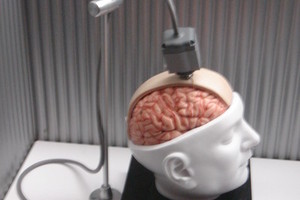
When Cathy Hutchinson drank a cinnamon latte from a thermos in 2012, she made history. When she went on to type words, send emails and navigate a wheelchair, it sent waves of excitement through the neurosciencehttp://www.wired.co.uk/neuroscience research community. Hutchinson’s accomplishments were doubly sensational: not only was she the only almost-fully paralysed person to pick up her own coffee cup and drink from it, but she was also the first to do it entirely using her mind.

In this week’s podcast, we talk about BrainGate – a brain-machine interface that reads the brain’s instructions on movement, and translates those into a set of commands for a prosthetic arm. This means a person like Hutchinson, who has locked-in syndrome as a result of a brainstem stroke, can simply think about moving their arm and direct a prosthetic arm to do her will. Before Cathy began the trial, a 1mm silicon chip containing 100 electrodes, manufactured by Utah-based Blackrock Microsystems, was surgically embedded into the part of her motor cortex that controls her arm and hand movements.
The chip listens to chatter from the motor cortex via a dozen neurons that are threaded through the electrodes. Protruding from the top of Hutchinson’s head is a black plastic nub, resembling a tiny top hat. Extending from it, a thick cable links the brain chip to a large cart of electronics. The machine hums loudly, screens displaying a pattern of spikes spitting out loud static. These are Hutchinson’s neurons signaling to each other; the cart is reading her thoughts. The cart will ultimately turn the spikes into simple instructions – up, down, left, right, grpip, open – that the prosthetic arm can follow.
There are nine participants in the BrainGate trial, who have been paralysed due to a variety of reasons including stroke, amyotrophic lateral sclerosis or ALS, and spinal cord injuries – and so far the system has worked successfully in each of them. The next step: to move to a wireless system that allows the patient to be mobile, while they use BrainGate at home. Brown University neuroengineer Arto Nurmikko is working on a solution: in December last year, he published a paper describing a new high data-rate, low-power wireless brain sensor that could replace the nub and thick wires currently stemming from Hutchinson’s skull.
It is composed of two elements: a 100-channel transmitter that measures five centimetres and weighs 46.1 grams. This transmits data from the neurons at 100mb/second over a few metres (comparable to your internet speeds at home), and a four-antenna receiver that looks like a home Wi-Fi router. The system was tested successfully in rhesus macaques, where it could read movement data from their brains while doing variety of activities including running on a treadmill, but the researchers are awaiting US FDA approval before it can be tested on humans.
http://www.wired.co.uk/news/archive/2015-04/13/braingate-interview
